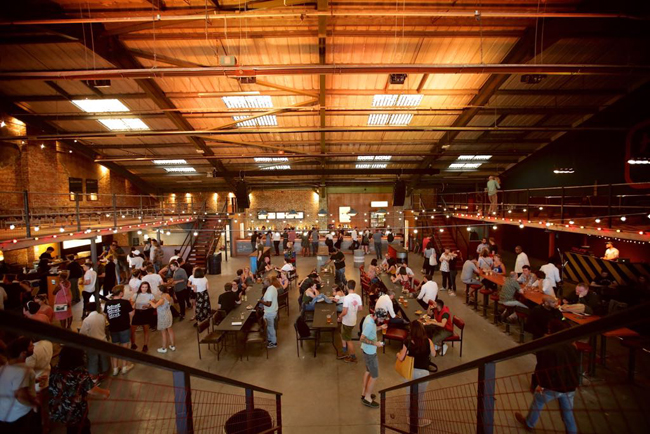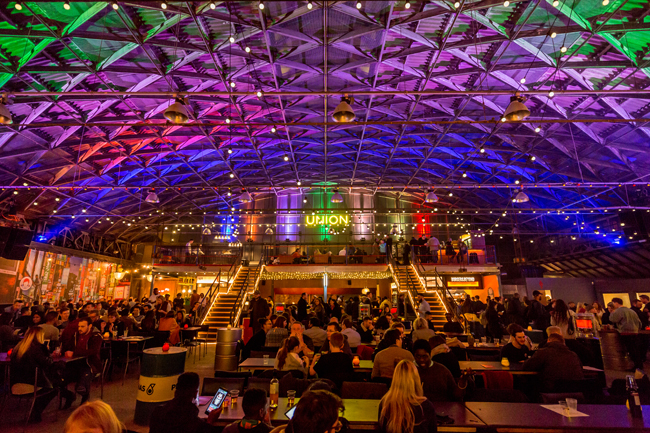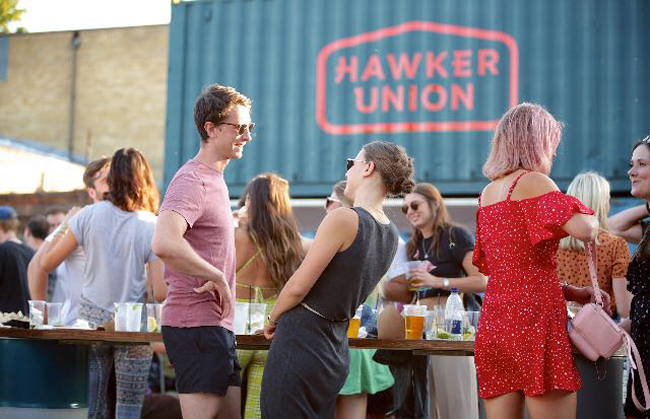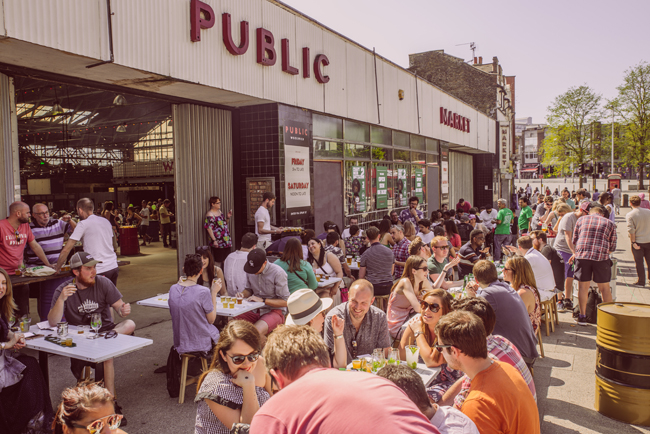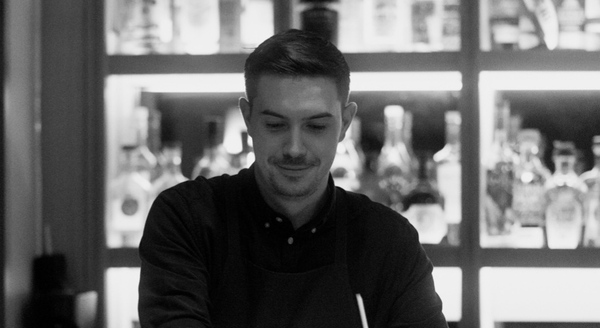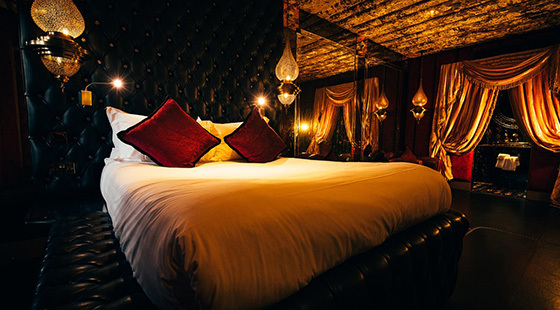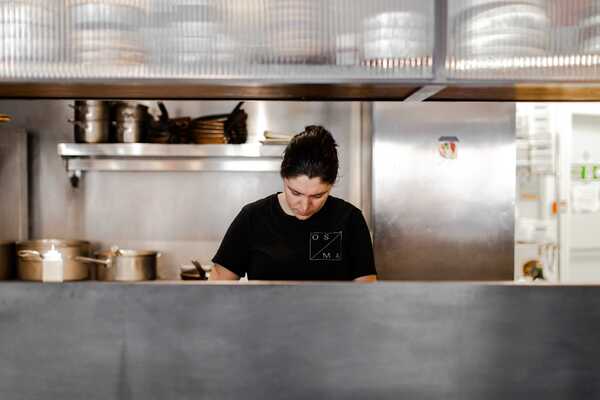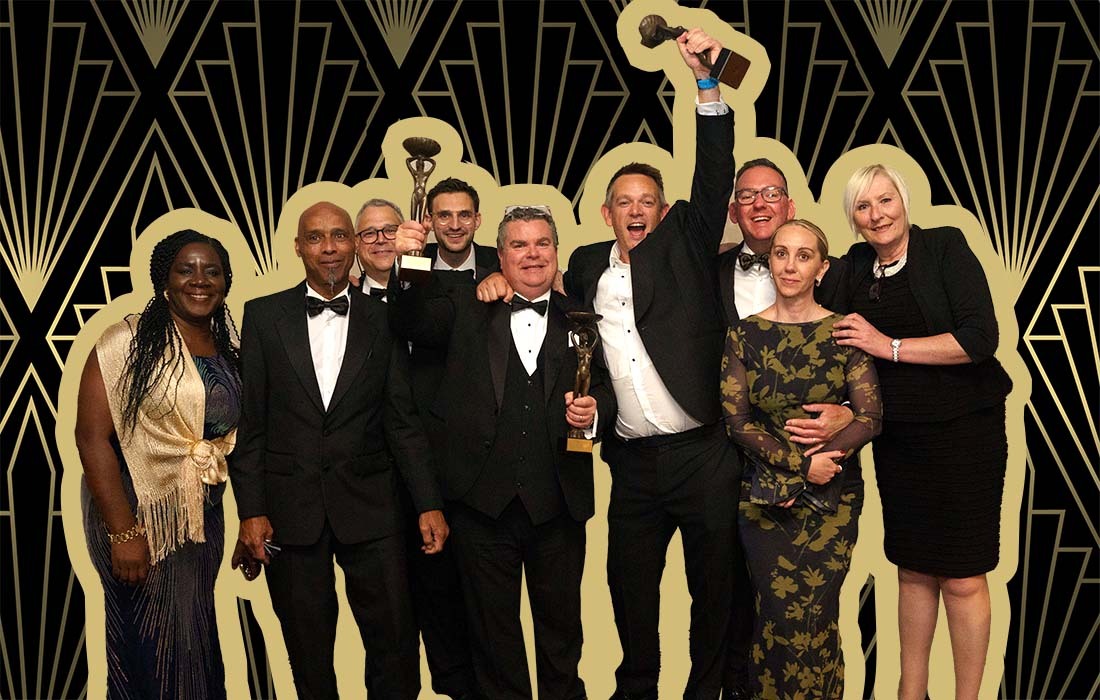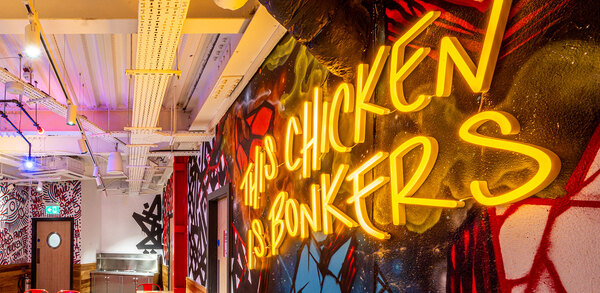Urban legend: Jonathan Downey, the man behind Street Feast, on bringing quality dining to derelict London
Whether it's Yumplings or a rotisserie burger from Henhaus, the dining public can't get enough of street food. And Jonathan Downey, the creative mind and energy behind the £13m Street Feast business, is always on the hunt for the next big thing, looking to expand his empire to the US, but always ensuring the offer is delicious. So, he asks, why aren't the ‘serious' chefs getting in on the action? He talks to Emma Lake
Jonathan Downey is an "instinct guy", not afraid to take a gamble on an out of the way site, to help launch a new street food business or to lock horns with local authorities (or possibly any authority).
The founder of London Union, the business behind the capital's six Street Feast markets, opened his latest venture, Hawker Union, in Wood Green in London last month in circumstances that would have seen many operators hyperventilating as they reached for the bottle.
Downey had invested a third of his budget before pen was put to paper to secure an industrial estate site with no potential customers living within a 500-yard radius. Just 72 hours before opening he didn't have a licence and, as a consequence, the lease was not signed off. Nevertheless, Hawker Union opened with six street food traders, five bars, a massive sound system, trampolines, pool tables and big screens, attracting 2,400 people in its first weekend.
Downey thrives on this intensity, and the hold-ups, particularly those caused by local authorities, regularly provoke social media rants from him against "unnecessary, waste-of-time distraction and hassle" that slow down the creation of jobs and transformation of unused space.
He explains: âDom was on the tube to Haggerston and the train was packed. When he got off, everyone else got off, and they were all coming to Street Feast. Thatâs when we thought âfuckâ. It was mobbed, but it was so much fun. As a result of Street Feast I stopped going to music festivals because I was getting the same hit of good food, music, drinks, people â" that whole vibe, but in Dalston or Haggerston.â
Downey took over the concept and has since created street food markets in disused car parks, old markets, rooftops, office blocks and industrial sites. Venues are filled with shipping containers, oil drums, school-style tables and chairs, strung up lighting, large bars and a wide variety of street food traders with offers including steamed buns, dumplings, burgers, tacos, wraps, pizza, steak, seafood and desserts, as well as every conceivable form of jerk, fried and rotisserie chicken.
The set-up may sound achingly trendy, but it has proved its appeal while winding its way to the financial hub of Canary Wharf, as well as sites in Woolwich, Wood Green and Lewisham â" where a Wimpy or a JD Wetherspoon had previously provided the standard fare.
Spoiled for choice
Downey says: âI think what weâve done is provide a generation with a new choice of how to eat and spend their evening. You come to Dinerama and you have nine mini-restaurants to choose from. They all specialise in one thing, but theyâre really good at it. If all you do is chicken wings, they will be good, if all youâre doing is tacos, theyâre going to be really good, and itâs at a reasonable price point because theyâve not got the overheads of a restaurant.
âYou can come as a group and all choices are catered for, so youâre not arguing with eight mates about whether you should go to a French restaurant or sushi or vegetarian because theyâre all here. And when itâs all put together, the music, the food and the drinks on this scale in 1,000-1,500 capacity venues and in the spaces, itâs something new happening somewhere itâs never happened before.
âI remember when I first brought my friend Andy here [to Dinerama in Shoreditch], and he said âitâs like being in Brazil or somethingâ. Thatâs the reaction we love: when people were not expecting something like this and they immediately like it.â
The majority of the sites, with the exception of Giant Robot in Canary Wharf, are taken on with short-term leases. He says: âWeâd prefer longer leases so we can spend and invest more money. Weâve got a 10-year lease on Giant Robot. Canary Wharf came to us with a super-interesting site, looking for an interesting bar and food offer that could change to attract a captive audience who have been to Itsu and the like.â
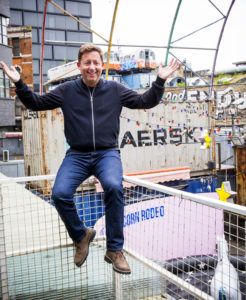
As well as having the potential to be financially lucrative, Downey says the model offers the chance to be flexible âwithout spending hundreds or thousands of poundsâ, which can help to keep customers engaged at a time when an abundance of choice has worn away consumer loyalty, particularly among a younger audience.
Street Feast tries to recruit traders locally, such as pizza offer Rust Bucket, whose eviction from a Woolwich shipping container last year saw locals scrambling to sign a petition to allow it to continue trading on council-owned derelict land. Downey wants to keep evolving the offer of sites, whether by changing traders or encouraging existing concepts to diversify with new dishes and vegan and vegetarian options.
The road to profit
Itâs a model that has produced some great success stories. Mother Clucker, which had been stationed in Hawker House and Model Market, has opened its first bricks and mortar restaurant, as has Smokestak and Breddos. Downey believes traders at seven-day-a-week Giant Robot in Canary Wharf could be achieving turnover of upwards of £1m a year.
âWe were very early with good cocktails and then everyone piled in and started doing overly sweet, sickly, horrible cocktails and that affected everyone. If youâre good at what you do, then I admire you and applaud you and support you, even if youâre a bit like us.â
Downey stresses he wants to do more to use the influence Street Feast has generated through its 139,000 Twitter followers, 157,00 Instagram followers and 102,000 Facebook followers to support the industry â" even those not trading from his sites.
He says: âIf you look at London food influence weâre really significant and I donât think weâre using that enough to support people like Smokestak and Breddos. We should be guiding our followers a bit more â" about 70% Street Feast, about 30% other people.â
There seems to be no stopping Street Feast, and in the week we meet Downey has put pen to paper on the Wood Green site as well as visiting other potential sites. He says: âWe could probably do 10 to 12 sites in London, three in Manchester â" weâre chasing three sites in Manchester â" probably one in Bristol and then we have to go to Europe or America. In the middle of last year, I had three fantastic sites lined up in Williamsburg, Manhattan and Miami. We had massive contributions from landlords, but we just werenât ready.
âManchester is definitely happening. Weâve not signed anything, but itâs happening. Iâm from Manchester but Iâve never wanted to open a business there until this year. Iâve seen the changes over the past few years and it feels like itâs not just a second city, it feels like a major European city with its own identity.â
Downey is not too concerned where these sites are in his chosen cities: âI almost donât care where it is as long as long as we have a great space to work with. Thatâs a consequence of thinking that if weâve got a great space we can put something in it and people will come.â
Getting customers in is one thing, but Downey is aware of the much-discussed problems of instilling consumer loyalty in millennials or Generation Z. And it may not surprise you to hear that he doesnât believe that Instagrammable backdrops are the answer.
He says: âI donât think about a site being Instagrammable. We toyed with it in the past when somebody was suggesting that we get an influencer and I looked at what he was doing and everything was paid for, everything was meaningless and shallow and hollow. Weâve got to be more real than that and do good food for nice people.â
He adds: âThat younger generation are not becoming regulars; theyâll come a few times a year if youâre lucky before they move on to the next thing. What we try to create is that each site becomes the next thing by changing the offer, by changing the food, changing for the seasons, so roof off in the summer and then fires in the winter.â

Is there a point when new sites and new traders canât sustain Street Feastâs appeal? Downey says: âI think there will be ups and downs. It depends largely on me and what I bring to the business and the people in our team. If I were to look at the next five years I think weâll be fine â" weâll open loads of great sites. One or two might not work, but generally everything is going to be brilliant. Looking 10 years down the road, itâs harder to say â" itâs not as obvious.
âIâm getting on a bit now and I could really do with someone half my age whoâs out there finding all the new, cool stuff. I reckon Iâve got two or three years left in me before I want to sit in an armchair. Iâve not lost it. I have moments when Iâm knackered or fed up, but thatâs transitory; itâs an hour or a day and then Iâm back in the saddle pushing the team.â
In the meantime, the reluctance of professional chefs to join him aside (see panel), Downey appears to still relish the Street Feast vibes: âLondon is the best place in the world for street food right now. Some people prefer New York, but itâs not got the variety or the quality. We spend way too much time celebrating our Michelin-starred chefs, whereas one of the most delicious things you can eat is a yumpling.â
About Street Feast
www.streetfeast.com
London locations Hawker Union Wood Green N22
Dinerama Shoreditch EC2A
Giant Robot Canary Wharf E14
Hawker House Canada Water SE16
Public Woolwich SE18
Model Market Lewisham SE13
Sample dishes
What the Fattoush Vegan food, including dukkah-dusted chickân fillet with feta-style cheese, Middle Eastern slaw, pink pickled onions and mint cashew cream in a brioche bun
Henhaus Rotisserie chicken, chips and slaw
Ink Crispy squid, pickled chilies, coriander, spring onions and sesame dressing
Yumplings Steamed pork dumplings with xian-style sauce and sesame seeds
Chin Chin Labs Sticky toffee warmie: warm sticky toffee cake, caramel, white chocolate shell, pecans, gold salt
âChefs: get out of your basement kitchensâ
Despite his confidence that the London street food scene is the best in the world, Downey is concerned that the rate of innovation is slowing and he wants to encourage more professional chefs to enter the sector.
He says: âThe street food scene in London is evolving a lot slower than I thought and it needs a step change now. We made a commercially sustainable business that gave operators a regular space to trade, the crowds came, and they made some decent money.
âI think people have settled into that comfort zone. Iâm constantly looking for the next burst of quality and creativity and imagination or weirdness or newness and it trickles in, itâs not pouring in. Iâm surprised there are not more professional chefs in street food.
âGet out of your basement kitchens, working 70 hours a week, being shouted out and having knives thrown at you. Come and work where you can communicate directly with your customers.
âItâs rewarding, emotionally and financially. I thought weâd have some real kick-ass, creative, professional chefs coming into the industry and raising the bar, but itâs not really happened like that.â



